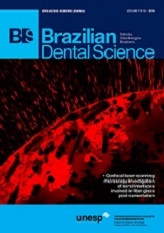Evaluation of root resorption levels in patients with bruxism
DOI:
https://doi.org/10.14295/bds.2014.v17i2.965Abstract
The aim of this study was to evaluate the frequency of the degree of apical root resorption by making a digital radiographic analysis of patients with bruxism and also to check whether there is any correlation between bruxism and root resorption. A total of 22 patients with the habit of parafunctional bruxism were selected. The patients underwent six digital periapical radiographs to evaluate teeth numbers 13 to 23 and 33 to 43 (a total of 264 teeth). These were evaluated by a calibrated radiologist and classified as: grade 0 - no root resorption; grade 1 - mild resorption; grade 2 - moderate resorption; grade 3 – severe resorption; grade 4 - extreme resorption. The result of the overall analysis was: grade 0 appeared in 223 teeth (84.5%), grade 1 in 34 teeth (12.9%), grade 2 in 7 teeth (2.7%) while grades 3 and 4 were not seen in any teeth in the study (0%). It was concluded that the 0 degree of root resorption (no resorption) had the highest frequency (84.5%); there was no positive correlation between bruxism and root resorption and tooth number 13 presented a rate of 27.13% for grade 1 root resorption (mild resorption).Downloads
Downloads
Published
How to Cite
Issue
Section
License
Brazilian Dental Science uses the Creative Commons (CC-BY 4.0) license, thus preserving the integrity of articles in an open access environment. The journal allows the author to retain publishing rights without restrictions.
=================




























